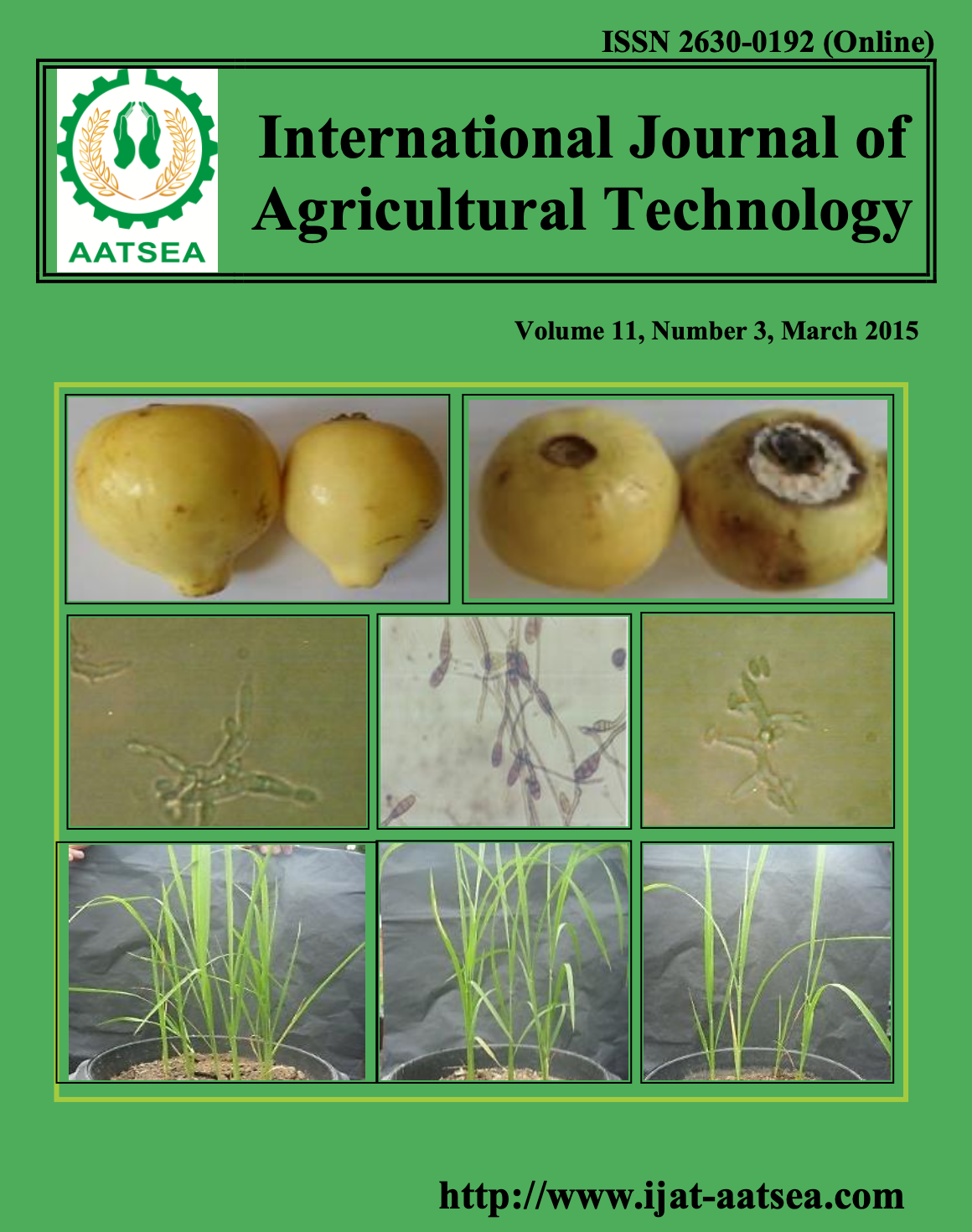Larvicidal and oviposition deterrent activities of essential oils against house fly (Musca domestica L.; Diptera: Muscidae)
Main Article Content
Abstract
House fly (Musca domestica L.) is one of the most important insect pests of household and livestock, their has been developed resistance to chemical insecticides. In fact, green pesticides derived from plant essential oils are an excellent alternative to synthetic pesticides. In the present study, the Thai essential oils derived from ylang-ylang (Cananga odorata Lamk), citronella grass (Cymbopogon nardus (L.) Rendle) and clove (Syzygium aromaticum L.) were evaluated for their larvicidal and oviposition deterrent activity against house fly and compared them with chemical insecticide (cypermethrin 10.0% w/w, kumakai 10®). The highest larvicidal activity and oviposition deterrent activity was shown by S. aromaticum oil with LC50 values of 9.83% and 100% effective repellency and -1.0 OAI at 1.65µl/cm2. Moreover, S. aromaticum oil also exhibited the higher larvicidal and oviposition deterrent activity than cypermethrin. However, toxicity assay indicates the order of LC50 values and percentage of effective repellency against house fly in three essential oils as S. aromaticum oil > C. odorata oil > C. nardus oil. These results clearly revealed that S. aromaticum oil served as green pesticides to control house fly population and safe for human and environmental friendly.
Article Details

This work is licensed under a Creative Commons Attribution-NonCommercial-NoDerivatives 4.0 International License.
References
Burdock, G. A. and Carabin, I. G. (2008). Safety assessment of ylang-ylang (Cananga spp.) as a food ingredient. Food and Chemical Toxicology 46:433-445.
EPA (2009). Active ingredients found in insect repellent. Retrieved from: http://www.epa.gov/pesticides /health/mosquitoes/ai_insectrp.htm.
Hanan, B. A. (2013). Evaluation of insecticidal activities of Mentha piperita and Lavandula angustifolia essential oils against house fly, Musca domestica L. (Diptera: Muscidae). Journal of Entomol and Nematol 5:50-54.
Isman, M. B. (2006). Botanical insecticides, deterrents and repellents in modern agriculture and an increasingly regulated world. Annual Review of Entomology 51:45-66.
Khan, H. A. A., Shad, S. A. and Akram, W. (2013). Resistance to new chemical insecticides in the house fly, Musca domestica L., from dairies in Punjab, Pakistan. Parasitology Research 112:2049-2054.
Kumar, P., Mishra, S., Malik, A. and Satya, S. (2011). Repellent, larvicidal and pupicidal properties of essential oils and their formulations against the housefly, Musca domestica. Medical and Veterinary Entomology 25:302-310.
Kumar, P., Mishra, S., Malik, A. and Satya, S. (2012). Insecticidal evaluation of essential oils of Citrus sinensis L. (Myrtales: Myrtaceae) against house fly, Musca domestica L. (Diptera: Muscidae). Parasitology Research 110:1929-1936.
Kumar, P., Mishra, S., Malik, A. and Satya, S. (2013). Housefly (Musca domestica L.) control potential of Cymbopogon citratus Staff. (Poales: Poaceae) essential oil and monoterpenes (citral and 1,8-cineole). Parasitology Research 112:69-76.
Koul, O., Walia, S. and Dhaliwal, G. S. (2008). Essential oils as green pesticides: Potential and constraints. Biopesticides International 4:63-84.
Maipanich, W., Sa-nguankiate, S., Pubampen, S., Kusolsuk, T. and Iekka, A. (2010). Intestinal parasites isolated from house-flies in the tourist attraction areas in Thailand. The Journal of Tropical Medicine and Parasitology 33:17-28.
Morey, R. A. and Khandagle, A. J. (2012). Bioefficacy of essential oils of medicinal plants against housefly, Musca domestica L. Parasitology Research 111:1799-1805.
Palacios, S. M., Bertoni, A., Rossi, Y., Santander, R. and Urzua, A. (2009). Efficacy of essential oils from edible plants as insecticides against the house fly, Musca domestica L. Molecules 14:1938-1947.
Pavela, R. (2008). Insecticidal properties of several essential oils on the housefly (Musca domestica L.). Phytotherapy Research 22:274-278.
Phasomkusolsil, P. and Soonwera, M. (2012). The effects of herbal essential oils on the oviposition deterrent and ovicidal activities of Aedes aegypti (L.), Anopheles dirus (Peyton and Harrison) and Culex quinquefasciatus (Say). Tropical Biomedicine 29:138-150.
Shapiro, R. (2012). Prevention of vector transmitted diseases with clove oil insect repellent. Journal of Pediatric Nursing 27:346-349.
Sripongpun, G. (2008). Contact toxicity of the crude extract of Chinese star anise fruits to house fly larvae and their development. Songklanakarin Journal of Science and Technology 30:667-672.
Sinthusiri, J. and Soonwera, M. (2010). Effect of herbal essential oils against larvae, pupae and adults of house fly (Musca domestica L.: Diptera). Proceedings of the 16th Asian Agricultural Symposium and 1st International Symposium on Agricultural Technology. “Sufficiency Agriculture”. Bangkok, Thailand. pp. 639-642.
Sinthusiri, J. and Soonwera, M. (2013). Efficacy of herbal essential oils as insecticides against the house fly, Musca domestica L. Southeast Asian Journal of Tropical Medicine and Public Health 44:188-196.
Tarelli, G., Zerba, E. N. and Alzogaray, R. A. (2009). Toxicity to vapor exposure and topical application of essential oils and monoterpenes on Musca domestica (Diptera: Muscidae). Journal of Economic Entomology 102:1383-1388.
Trongtokit, Y., Rongsriyam, Y., Komalamisra, N., Krisadphong, P. and Apiwathnasorn, C. (2004). Laboratory and field trial of developing medicinal local Thai plant products against four species of mosquito vectors. Southeast Asian Journal of Tropical Medicine and Public Health 35:325-333.
Trongtokit, Y., Rongsriyam, Y., Komalamisra, N. and Apiwathnasorn, C. (2005). Comparative repellency of 38 essential oils against mosquito bites. Phytotherapy Research 19:303-309.
Warikoo, R., Wahab, N. and Kumar, S. (2011). Oviposition-altering and ovicidal potentials of five essential oils against female adults of the dengue vector, Aedes aegypti L. Parasitology Research 109:1125-1131.


